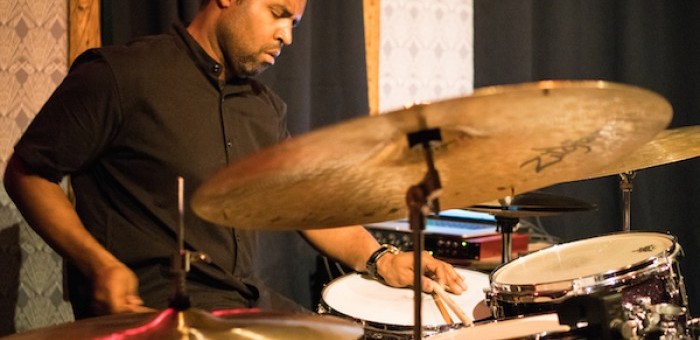Oct 28, 2025 10:47 AM
In Memoriam: Jack DeJohnette, 1942–2025
Jack DeJohnette, a bold and resourceful drummer and NEA Jazz Master who forged a unique vocabulary on the kit over his…

Kendrick Scott demonstrates Sensory Percussion, a new drum trigger by Sunhouse, at Threes Brewing in Brooklyn on July 21.
(Photo: Courtesy Tenoch Esparza/Sunhouse)The drum company Sunhouse presented a riveting showcase for its new product, the Sensory Percussion drum trigger, on July 21 with the help of drummers Craig Weinrib, Kendrick Scott and Marcus Gilmore, who each revealed unique interpretations of the company’s new technology at Threes Brewing in Brooklyn.
“The possibilities are endless,” Scott said of Sensory Percussion’s technology. “Most drum triggers only understand one or two sounds. The Sensory Percussion triggers recognize 10 regions of the drum. You can hit the middle of the drumhead, the edge of the head, the edge of the head with the rim, the middle of the head with the rim. You can play a cross-stick, stick-on-stick, the shell of the drum and more. The SP triggers will even pickup a roll from the center of the head moving outward. You assign sounds and controllers to each region. It’s monophonic now; it will soon be polyphonic. That will be crazy.”
The music produced by the three drummers was of the “crazy” variety, with sonic revelations at every turn. While Scott used his acoustic drums to trigger samples (with Ableton Live), Weinrib and Gilmore used Sensory Percussion’s dedicated mesh heads and sounds.
Weinrib’s performance recalled a 1950s sci-fi movie soundtrack; Scott’s drums triggered a YouTube recording; Gilmore’s set recalled the electronic din of Juan Atkins and Aphex Twin.
Weinrib’s first piece began with the television broadcast of the 1984 launch of the space shuttle Discovery, with he drummer adding hi-hat and clavé accents to the sounds of the rocket ascending and the chatter of mission control. A looped refrain of “3-2-1” became a bed for improvisation, with Weinrib rolling furiously and clacking his rims.
His second piece referenced Max Roach’s “The Drum Also Waltzes,” adding conga and slat-drum sounds amid the piece’s 3/4 rhythmic pulse. Electronic sounds, layered percussion and agitated sticking followed, Weinrib grounding his improvisation in Roach’s jazz-waltz refrain.
Scott began by gently rolling on his drums with mallets, giving no sign of the fury to come. As he increased volume and velocity, slat drums spoke, interspersed with snare drum accents. Changing to a drumstick in his left hand, he added punctuation and specificity to his rhythms. A 4/4 beat underpinned a string synthesizer pad.
“Please Jesus, no. Please no. Please no, don’t let him be gone,” came the cries of Diamond Reynolds from the now widely circulated YouTube video, in which, moments before, a Minnesota police officer shot her fiancé, Philando Castile, as he sat in the passenger seat of the couple’s car, with Reynolds’ 4-year-old daughter in the backseat.
Scott’s snare and bass drum figures evoked the sounds of a firing squad: abrupt and emotionless.
“Stay with me,” Reynolds’ narration continued as Scott fluttered his hi-hats and cymbals. “We got pulled over for a busted tail light in the back and the police just … killed my boyfriend … he had a firearm and he was reaching for his wallet, and the officer just shot him in his arm.”
At this, a tremendous low note boomed through the venue and Scott became explosive on the drums. As Reynolds’ narration continued, Scott slammed his drums with righteous anger, drilling his snare drum and using his bass drum to trigger wailing synthesizer notes. He peppered the kit with an attack resembling machine-gun fire.
As the horror of the recording carried on, Scott ratcheted up his attack, adding blazing single-stroke rolls, driving cymbal crashes and heated full-set fusillades. In time, a groove emerged, providing a brief moment for the audience to take in the impact of Scott’s statement.
“The police just shot him for no apparent reason,” declared the recording, and Scott’s piece came to an abrupt end.
Joined by the vocalist Melodiousfly, aka J. Mitchell, Gilmore opened with rattling bells and dense cymbal rolls. Low synthesizer tones erupted like a video game run amok. A din of percussion similar to tuned ice-bells and a driving bass drum propelled the music forward. Fat, oily rhythms clambered and clomped.
Gilmore seemed to be searching, exploring the many facets of Sensory Percussion’s sample library—from clipped percussion to voluminous ocean currents, from a belching bludgeon to Roland 808s. Melodiousfly offered angelic vocals, but they didn’t seem to affect the drummer. Gilmore was lost in a world of electronic beats and synthesizer plumage.

Jack DeJohnette boasted a musical resume that was as long as it was fearsome.
Oct 28, 2025 10:47 AM
Jack DeJohnette, a bold and resourceful drummer and NEA Jazz Master who forged a unique vocabulary on the kit over his…

D’Angelo achieved commercial and critical success experimenting with a fusion of jazz, funk, soul, R&B and hip-hop.
Oct 14, 2025 1:47 PM
D’Angelo, a Grammy-winning R&B and neo-soul singer, guitarist and pianist who exerted a profound influence on 21st…

Jim McNeely’s singular body of work had a profound and lasting influence on many of today’s top jazz composers in the U.S. and in Europe.
Oct 7, 2025 3:40 PM
Pianist Jim McNeely, one of the most distinguished large ensemble jazz composers of his generation, died Sept. 26 at…

Drummond was cherished by generations of mainstream jazz listeners and bandleaders for his authoritative tonal presence, a defining quality of his style most apparent when he played his instrument unamplified.
Nov 4, 2025 11:39 AM
Ray Drummond, a first-call bassist who appeared on hundreds of albums as a sideman for some of the top names in jazz…

To see the complete list of nominations for the 2026 Grammy Awards, go to grammy.com.
Nov 11, 2025 12:35 PM
The nominations for the 2026 Grammy Awards are in, with plenty to smile about for the worlds of jazz, blues and beyond.…